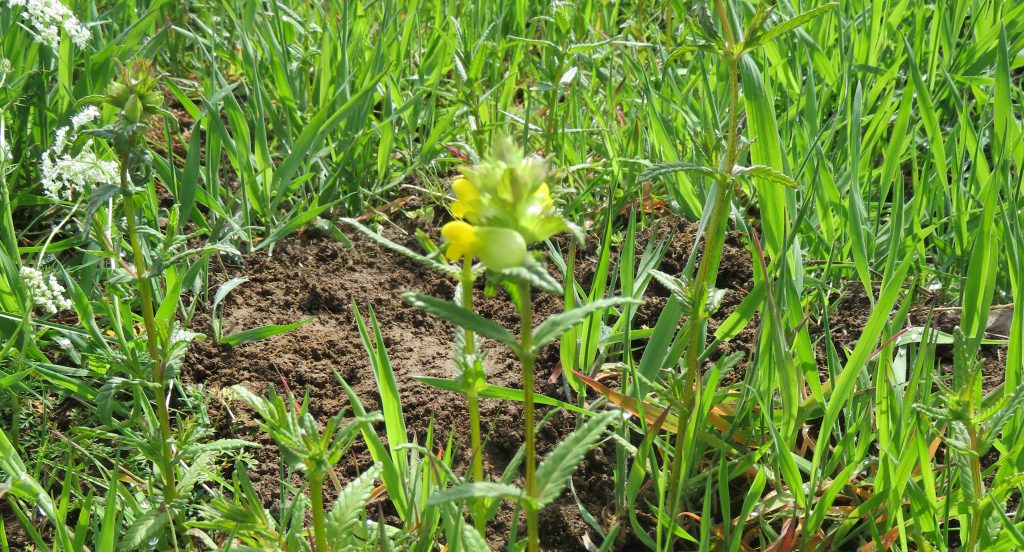
Inspired by the blog on the need to encourage more pollinators1 we have embarked on a wildflower meadow around our newly planted apple trees. Although Swaledale is rich in meadows, nationally meadows and other species-rich grasslands now cover less than 1% of the UK. Grasslands not only lock up carbon but also provide greater bio-diversity.
The chosen site slopes with shorter vegetation at the top and lusher taller vegetation at the bottom. There is currently a mix of flowers including bluebells, buttercups, cow parsley, dock, fox gloves, germander speedwell, hedge bedstraw, lady’s smock (aka cuckoo flower), nettles, sorrel, tormentil and yarrow as well as different grasses including the appropriately named Yorkshire Fog. We would like, however, to introduce some other flowers commonly found in Swaledale meadows such as ladies bedstraw, red clover and yellow rattle to increase its attractiveness to pollinators.
We started last October by introducing yellow rattle as it is the most important plant to establish in a meadow. Known as the meadow maker, it is hemi-parasitic and takes nutrients from the roots of grasses suppressing vigorous grasses. The seed doesn’t stay viable for long so Plantlife recommends you choose a reliable supplier to ensure it is fresh seed and from plants grown in Britain. You need to plant by November so that it has a few cold months to stimulate germination and the seed has to touch bare ground which is why it is recommended that you have at least 50% of soil bare. We followed guidance from the seed merchant and created 7 squares of 3 by 3 feet of bare soil and planted 10g of yellow rattle and 2g of yarrow. We have discovered that our squares were too big as most of the yellow rattle came up at the edges where there was grass that it could predate on and nothing came up in the middle. We would opt for smaller squares next time. Although not plentiful, we have been excited to see our yellow rattle flowering and if they successfully seed, we should see much more next year. The yarrow seed mixed in with the yellow rattle seed didn’t do much but I had kept some seed back to plant this spring in trays and have now planted the little seedlings out.
Plantlife has useful information on establishing meadows including advice on avoiding certain wildflower mixtures which bring together plants which don’t naturally occur together. As a result, we plan to introduce further plants over time by purchasing single species seed. In Autumn, once the flowers have seeded, we will cut the grass a couple of times with a scythe/strimmer and remove the grass and then sow some red clover seed with the hope the clover will attract more pollinators.
Now all we need now is a wildlife pond!2
1 Pollination – does it matter if our pollinators die out? (Spoiler – yes, it does). Sustainable Swaledale Blog 10 October 2019
http://www.sustainableswaledale.org/uncategorised/pollination-does-it-matter-if-our-pollinators-die-out-spoiler-yes-it-does%ef%bb%bf/
2 Build a Pond. Sustainable Swaledale Blog 11 May 2020.
http://www.sustainableswaledale.org/uncategorised/pollination-does-it-matter-if-our-pollinators-die-out-spoiler-yes-it-does%ef%bb%bf/
Further reading:
Plantlife: Using yellow rattle to restore wildflower grasslands
http://www.magnificentmeadows.org.uk/assets/pdfs/Using_yellow_rattle_in_restoration.pdf
Plantlife: Plants of wildlife meadows
http://www.magnificentmeadows.org.uk/assets/pdfs/Meadow_ID_Leaflet.pdf
RSPB: Start a wildlife meadow
https://www.rspb.org.uk/get-involved/activities/give-nature-a-home-in-your-garden/garden-activities/startawildflowermeadow/